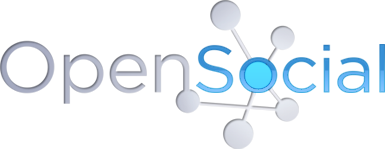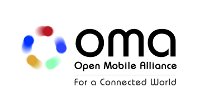Host
W3C gratefully acknowledges AppFusions for hosting this workshop.
Sponsor
If you're interested in being a sponsor, please contact J. Alan Bird at abird@w3.org or +1 617 253 7823. For additional information, please visit the Sponsorship program.
Important dates
8 July 2013:
Deadline for position papers
for possible presentation
(via email)
15th July 2013:
Program and position papers posted on the workshop website
31 July 2013:
Deadline for registration
(statement of interest required,
no participation fee)
Workshop Report
The W3C-OpenSocial Foundation joint workshop on Social Standards: The Future of Business convened with the goal of formulating a standardization strategy to make "social" a first-class citizen of the Web. The current landscape around social applications on the Web is fragmented, holding back business results; the Open Web Platform, with W3C's royalty-free patent policy, offers a sound base for moving forward. Conceived by the W3C Social Business Community Group, the workshop was hosted by AppFusions and sponsored by IBM and the Open Mobile Alliance. The workshop featured two-days of presentations and intense discussions of the challenges, use cases, and potential standardization strategies for social. The workshop brought together over 70 individuals from more than 50 companies around this theme, ranging from start-ups like Crushpath to established enterprise social networks like Yammer.
A number of points of consensus emerged:
- The W3C should establish a group responsible for coordinating activities and messaging in the social space – to include new and existing working groups, community groups and liaison with related activities in other standards organizations.
- The W3C should address the strong need for a high-level "Social Business Architecture" document showing how all the diverse pieces could be put together in a use-case driven architecture
- The OpenSocial Foundation and W3C will co-ordinate to establish one or more new Working Group(s) to create the next version of OpenSocial on top of the Open Web Platform
- Common data-formats and a process to adjudicate the evolution of definitions are both crucial for enabling social activity. ActivityStreams should be considered for use or at least compatibility with in data-formats for social activities, with the further pursuit in a Working Group of a version such as ActivityStreams 2.0 that supports URIs so that items of interest (status, relationships, verbs) can then be referenced via JSON-LD and Schema.org. Atom, JSON, and microformats2 should also be supported.
- As the "back-end" of social sites usually involves loosely coupled "NoSQL" graph-based data, this emerging consensus in industry should be matured into a "Property Graph" specification. Work on property graphs should be pursued in the Property Graph Model and API Community Group, in order to lead to a Working Group once matured.
- As the federation of social profiles is an urgent need for many applications, this work should be pursued in a Community Group initially, with potential transition to a Working Group. As much as possible, the group will leverage work such as by the PubsubhubbubCommunity Group and Federated Social Web Community Group.
The workshop built a strong alliance between the OpenSocial Foundation and W3C to make "social" a key process for businesses to create value. Given the move to mobile and device-independence (or multi-device dependence), building a common framework for social Web applications on top of HTML5 is a top priority. Leveraging the complementary strengths of both organizations can help make social standards a success.
This workshop built on the work of the Social Business Community Group, in particular the 2011 Social Business Jam and the 2012 CTO Guide to Social Business. Previous workshops on social included the Federated Social Web conference and the Future of Social Networking Workshop. The W3C feels that thanks to the work of the Social Business Community Group, critical mass has been reached within W3C membership to make social standards a full-featured part of the Open Web Platform.
Meeting minutes for August 7th and August 8th are available online.
The Business Case for Social Standards
Dion Hinchcliffe of the Dachis Group (slides) opened the workshop with a keynote calling social media the largest communication revolution since the Web itself. The lack of underlying standards to social media stunts businesses' ability to get in touch with their own users and customers. Simplicity is key to success with standards for business, Hinchcliffe said, pointing to the success of RSS over Web Services. With "hundreds of social networks with over a million users" unable to talk to each other, the network effect is being lost.
Mark Crawford of SAP (slides) explained how, based on SAP's experience with the SAP JAM Social Business Solution, that social must move beyond from personal relationships based on proprietary stacks to integrated business relationships based on standards. The vast majority of business-related processes are non-transactional in nature, requiring social interaction involving people, content, applications, data and processes (learning, internal communities, HR management, supply chains, onboarding new employees). It is essential that these social processes are integrated into business applications to accelerate real business performance rather than be lost in the "black hole" of traditional interactions. Since companies employ many diverse packages of software across heterogeneous environments, semantic standards around social business content and the contextualization of that content are the way forward.
Ed Krebs of Ford (slides) followed by detailing a reference architecture that illustrated both the current landscape fragmentation was and the possibilities for a unified architecture. Such a unified architecture will significantly ease the effort required by engineers for engineers to build enterprise social networks that can successfully interoperate both within and between large and small enterprises such as Ford and its supply chain. Storing files in multiple places is not efficient, and "nuggets of wisdom" are lost that are crucial to the business.
Don Buddenbaum of IBM (slides) presented on how 'social' has to be embedded where people do their work, with metrics included so businesses can understand the concrete results of using social.
Lloyd Fassett (Azteria) gave a presentation on how social standards could evolve business models from "pipes to platforms" rapidly. There are significant non-technical issues to consider as a standard for interactions and collaboration itself has the potential to become a non-proprietary, open platform.
Use-cases
The Workshop then turned to the question of what concrete use-cases could be addressed using social standards?
Li Ding of Memect (slides) provided an analysis suggesting that all use-cases could be thought in terms of providing an extended memory for a business.
Monica Wilkinson of Crushpath (slides) discussed how standards help start-ups ship working code faster, saying that her start-up deploys a vast variety of standards, ranging from de-facto closed work such as the Open Graph Protocol (Facebook's "Like" Button) to community-driven work like ActivityStreams.
Eric Meeks of University of San Francisco (slides) argued that Linked Data complements OpenSocial, and demonstrated how it enables academic social networking.
Adam Boyet of Boeing (slides) pointed out how their custom-built InSite social platform allows "connections everywhere" to enable both internal and external collaboration and expert-finding for Boeing, but authentication and federation of identity profiles were major pain-points in integrating InSite with other products like Microsoft SharePoint.
Dan Schutzer of FSTC (slides) reminded the audience that deployment in the financial sector depended on privacy and security to protect users, as well as a focus on risk and compliance that are necessary to deal with anti-fraud and disclosure requirements. The group at large engaged in a detailed discussion that focused on expert-finding, as well as identifying the right context for expertise. Discussion took place over the difference between social platforms and traditional collaboration software, with the key difference being that collaboration software is focused on pre-existing teams while social software is meant to help a business discover connections that it might not even be aware of - both between the employees of a business and between a business and its customers.
Social Standards Architecture
Monica Lam of Stanford's (slides) presented a keynote on "How Mobile Revolutionizes Social". She raised the case that mobile could revolutionize social, as phones are essentially thin clients to social networks. Lam followed with a demonstration of an application that let users create their own ad-hoc social networks without servers based on their phone. Her presentation highlighted a fundamental social business question that needs to be addressed - as social standards are currently spread across multiple standards-bodies and grass-roots efforts, how can we unite them into a coherent "social platform" built on top of the Open Web Platform?
Bryan Sullivan of AT&T (slides) noted that a social architecture would have to scale globally in a mobile environment, and demonstrated how the Open Mobile Alliance had already constructed a draft architecture (SNEW) based on pre-existing work such as OStatus. There was still much work to be done, such as integration with NFC and multi-factor authentication, and ActivityStreams templates were needed to standardize various common workflows. Lastly, user control and privacy were still major open issues.
Fabio Mondin of Telecom Italia (slides) showed that a mobile social networking could even increase network efficiencies. Their work with the eCousin project allowed reduced network usage by, for example, placing social content closer to the location of the event. To enable these kinds of use-cases, the social networking architecture needs to be able to communicate with the networking architecture.
Jason Gary of IBM (slides) pointed out how events and roles need to be embedded in ActivityStreams, but currently profiles do not support roles despite roles having the ability to be the "killer app" for social.Gary sees a solution through creation of a general event and data model for use by application developers, leveraging existing standards and technologies including PubSub (MQTT), Linked Data (JSON-LD) and Message Payload (ActivityStreams).Discussion over the importance of roles between roles ensued. Discussion over the importance of roles between roles was brought up.
Ashok Malhotra of Oracle (slides) brought up the fact that the back-end of social networking sites store massive property graphs, a graph-based data-structure where lists of properties are attached to each node. Currently the details are different for how each vendor stores property graphs, and Oracle would be willing to make a submission to the W3C to start work in standardizing them. It is currently unclear how much of property graphs could be handled by the RDF data model.
Federating the Social Web
Matt Franklin of W20 Digital (slides) started with a call to action on how a new generation of standards to federate the social web, building on top of OpenSocial and ActivityStreams, would be necessary. In particular, OpenSocial does not address identity and the social graph, and ActivityStreams needs to have better interoperability with processing rules and levels of visibility. Given that the proposed next version of ActivityStreams is using the JSON-LD format,
Gregg Kellogg (slides) discussed how, given that the proposed next version of ActivityStreams is using the JSON-LD format, and JSON-LD adds URIs and links to JSON, JSON is compatible with the RDF data model.
Ed Krebs (Ford) (slides) made the case federated architectures require what he terms a "PubSubHub" system wherein new business systems will be able to feed data to each other without changing other servers.
Sam Goto of Google (slides) discussed how schema.org was being extended to take on actions (essentially a taxonomy of verbs), similar to the "Embedded Experiences" of OpenSocial where verbs can take on well-defined subjects and objects with semantic roles.
Theodoros Michalareas of VELTI (slides) presented a research paper developed as a part of the EU-funded project OPENi (Open-Source, Web-Based, Framework for Integrating Applications with Social Media Services and Personal Cloudlets. The paper makes a case for the OPENi API, which provides for 1) a social graph-rooted framework that builds on existing social standards and allows developers to easily source into their applications a broad spectrum of existing cloud-based, user-centric functionality and content as well as 2) a Context API framework that allows to build context to the developed applications and extend the social graph connectivity model so that consumers can express both weight and connectivity of their connection to other parts of the social graph.
Considerable discussion over the choice of data-formats (HTML with Microformats2, JSON-LD, and ordinary JSON) as well as the relationship of context to security concerns also took place.
Next Steps for OpenSocial
OpenSocial is the foremost API for enterprise social applications, and its evolution will help drive the open social web.
Mark Weitzel of Jive and Andy Smith of IBM (slides) gave an OpenSocial "State of the Union" address, in which they laid out a plan for building the next version of OpenSocial on top of the Open Web Platform. OpenSocial has always been focused on securely sharing context bi-directionally with applications. A new version of OpenSocial that builds on top of Shadow DOM and Web Components will let developers build OpenSocial applications in the same style as any other HTML5 application while maintaining OpenSocial's ability to share context and create "embedded experience" that prevent users from losing their context.
Beth Lavender of MITRE (slides) built on Mark and Andy’s points by discussing how their work allowed MITRE to view a business either at a particular point in time or view the business as activities were occurring in "real-time."
Ellen Feaheny and Patrick Li of AppFusions, the host of the workshop, (slides) discussed the critical importance of standards to allow for more mainstream proliferation and adoption of OpenSocial implementations. As examples, they illustrated packaged integrations that AppFusions has developed that brings together IBM Connections and Atlassian applications, and Jive and Atlassian applications. While the implementations are unique from each other given different platforms, they also share some application elements such as their usage of OpenSocial APIs and OAuth, among other.Shared design allows for more rapid development success.
Shane Caraveo of Mozilla (slides) presented Mozilla's new "Social API" that embeds capabilities to the user agent's sidebar such as notifications, social bookmarking, share, and chat windows.
Dimitri Glazkov of Google (slides) then gave an in-depth presentation on Web Components, which led to considerable excitement on how OpenSocial could work together with Web Components and other new capabilities being developed in HTML5.
Running Code
Inspired by the IndieWeb Camps and Federated Social Web Community Group's "Federated Social Web Summits", the workshop hosted a session of demonstrations of running code.
Tantek Çelik (slides) of Mozilla began by introducing the idea of "IndieWeb", based on the twin principles of Own your own data, Eat your own dogfood, and Publish Own Site, Syndicate Elsewhere.
Evan Prodromou of Status.Net presented his new "Pump.io" codebase for an ActivityStreams server with varying degrees of privacy, allowing streams to be filtered and writable only to certain groups.
Ben Werdmueller of Lakatoo (slides) presented Idno, a social publishing platform built just on top of HTML5 and microformats. Users should be put first, and beware of putting technology before usability.
Patrick Deegan of ID3 demonstrated Open Mustard Seed that uses virtual machines to created trusted applications bundles. Their goal is to create a new social ecosystem of trusted digital institutions based on personal data.
Aaron Pareki (slides) of Esri R&D Center demonstrated indieauth, an implementation of rel=me auth, a technology that enables domain names as an identity (rather than email as an identity), by delegating your authentication provider to existing accounts on services that support Oauth (such as twitter, github, flickr, etc). It also allows for alternate authentication methods such as TOTP (google authenticator) and SMS authentication. As part of his presentation, Aaron demonstrated passwordless TOTP authentication via indiauth where his pebble watch provided him with TOTP code.
Bret Comnes demonstrated his personal blogging platform which is built off of jekyll and hosted for free on github-pages, including ability to post comments to the site, and have the contents of the comment (or RSVP status to an event) automatically syndicated and displayed to other 'indieweb' enabled websites using a combination of webmentions and microformat-2. The result of this is displayed as a twitter-like conversation thread made up of posts from across different personal websites. This particular implementation is done using completely static html and post commit hooks, which helps demonstrate the simplicity and viability of these different tools.
Access control (distribution control of ActivityStreams) and consumption of ActivityStreams were mentioned as outstanding problems, with a client API for ActivityStreams and WebMention brought up as possible solutions.
Next Steps
At the end of the workshop, break-out groups met to discuss areas to be standardized next. Groups formed around the following topics:
- OpenSocial and Gadgets will focus on radical simplification leveraging HTML5, moving from the XML definition of a gadget to a situation where AJAX requests are performed directly against a page. How context works with cross-origin requests and how application tags can be supported by HTML5 are the next steps.
- ActivityStreams will focus on a new version, ActivityStreams 2.0, to increase extensibility and handle state. There was a large discussion over the role of JSON-LD as a syntax for ActivityStreams, but as ActivityStreams 2.0 does not depend on it, it was viewed as acceptable to the workshop participants.
- Identity and Profile Federation needs to focus on a set of core attributes that show how previous work in the area (hCard and vCard in particular) can be extended with desired features such as skill-levels and certifications. It is necessary to understand how profiles federate using protocols such as Pubsubhubbub.
- IndieWeb will focus on user experience, in particular making it much easier to use the reply button and work with browsers to make it easier to share content.
- Property Graphs need to have their data model defined, as well as APIs and schemas. Potential cross-over work on exploiting property graphs with the OpenSocial API should be investigated.
- Linked Data and vocabularies need to focus on how to create new kinds of vocabularies that can enable social business, such as expertise vocabularies.
Additionally, R.V. Guha of Google came to answer questions about licensing and transparency of schema.org. After hearing concerns about asymetries in the schema.org patent license, Guha said he would investigate whether changes to the terms of use were warranted.
Interest in following through with each of above topics was fairly well distributed, with more than ten people interested in continuing concrete work on each.
- The Social Business Community Group, having met its objective of identifying the next steps for W3C's social business work, will evolve into an Interest Group to handle messaging and co-ordination responsibilities.
- New technical working groups on ActivityStreams, OpenSocial, and possibly federation (Pubsubhubbub Community Group) should be pursued.
- Property Graphs and Profile work should happen in Community Groups in order to reach more maturity.
- Schema.org would continue to work with W3C and other grassroots communities to make its process more open and transparent for vocabularies.
Conclusion
All participants are invited to join the Social Business Community Group in order to help draft the charters for new work, including the transition of the Social Business Community Group into the Social Business Interest Group. Other interested parties can also join the Social Business Community and participate in this exciting area as the future of social business on top of the Web is planned and built. The W3C does not require membership to participate in the community groups, and this is a good opportunity to get yourself in on the ground floor to both guide the direction and evaluate if a stronger role as a W3C member in these new activities is important for you. Even if you missed the workshop, you can join the conversation to build the next version of social on top of the Web!
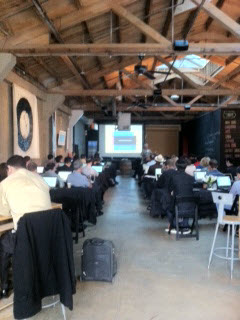
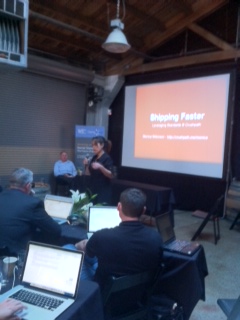
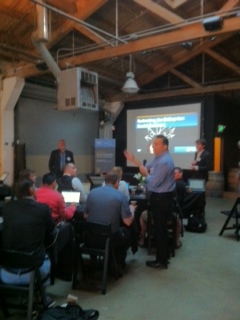

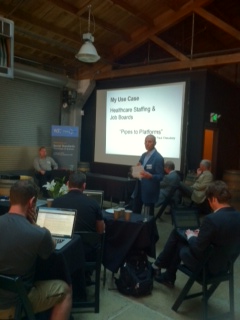
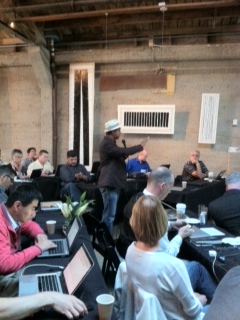
Attendees at workshop (Group Picture, Monica Wilkinson (Crushpath), Mark Weitzel (OpenSocial Foundation), Ann Bassetti (Boeing), Lloyd Fassett (Azteria), and Rawn Shah (Alynd) — Photo credits: Ellen Feaheny

